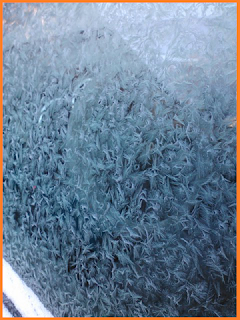Frosted sabers.
Icy feathers.
Whatever you see when you look at the patterns, you have to agree that they're breathtaking.
What patterns?
Well, yesterday morning I walked outside to take my daughter to school, and stared at amazement at my car windows.
I've seen frost patterns plenty of times before, but these patterns were different from anything I'd seen in the past. I wondered why.
I mean, I know the basics.
As water freezes, the molecules line up, so to speak, and that's what produces the pretty shapes. Windows never (or at least, very rarely) frost up with any kind of symmetry. There are too many impurities. Dirt, dents, oily fingerprints, etc. This is why frost on windows is so different from snowflakes that fall from the sky.
This wasn't my problem. Rather, I wondered why the frost patterns on my windows here, in Southern Minnesota, were so different from the patterns on my windows when I lived in the desert. It has to do with the temperatures and humidity, obviously...
But how? I needed an explanation.
After a while, I found Seabrooke Leckie, a writer and naturalist. Within a few sentences of her post on frost feathers, I knew she'd appeal to both the scientist and the dreamer in me.
She explained that you need a catalyst. Something for the molecules to adhere to. Dust, pollen, threads from a spider web...
My car hasn't been washed in around a year.
I have catalysts galore!
She goes on to say that
"The specific patterns of the feathery growths from the catalysts depends on numerous factors including, but not limited to, air pressure, air temperature, surface temperature, humidity, and even imperfections of the surface."I was right about the temperature and humidity aspects, but air pressure was something I had never considered.
I traveled over to hubpages, where I found a piece dealing with dew point and frost formation.
This taught me that as pressure increases, more water is able to form in the air (This gives us dew). I know, I know... this is Basic Weather 101. Go easy on me... I'm from the desert. Humidity is not something I've ever truly had to spend time thinking about!
Frost forms when the dew point falls below freezing.
The water on a frosty surface, though, is icy from the beginning - it never gets the chance to become dew. It's formed from water vapor, itself. Sublimation: We go directly from a gaseous state to a solid state. Fun!
And the author even gave me a bit of forecasting knowledge to play around with!
"The ideal conditions for the formation of frost is a night with clear skies, light winds, and a temperature forecast to be near or a little below freezing."Even better than that, though... he mentioned 5 types of frost:
Hoar (stop the snickering!),
advection (this one just sounds cool),
window, and
white frost,
as well as frost flowers.
Nice!!!
So which one did I have?
It was on a window, so window frost was undoubtedly the answer. Window frost forms on... windows. Obviously. But! The same frost pattern was on the table that you constantly see in my farmers market posts, so obviously that explanation was too vague.
I needed more. Again.
This time, though, I had to rely on my own reasoning skills. Scary, huh?
I read about frost types, frost conditions, and window frost, specifically. Cal Tech had a very simple explanation of frost types that, though very basic, was also very enjoyable. I drowned myself in the basics until I was sure of the explanation. I had finally put to rest any doubts I had about my own theories.
Basically, the reason that frost here, versus the desert southwest, is so different, is because of the humidity mixed with the temperatures.
It snowed the morning before, so there was plenty of moisture in the air. Temperatures that evening had been in the 20s. Furthermore, there was a very light wind blowing through that had robbed the clouds from the sky, allowing heat to escape the atmosphere, reducing night temperatures even more, and allowing the ice particles to form on my very dusty windows.
High moisture + wind + quickly decreasing temperature = big frost feathers
This is a difference from my old desert home, because of the high moisture factor. Hence, in the desert, the individual threads of frost, while still covering the window, are much smaller.
Woohoo!!! I learned!
And I got to admire nature's beauty up close and personal.
As we walk the trails toward becoming more environmentally responsible, learning why things happen the way they do helps us to understand why it's so important to go green. It gives us a sense of wonder, and a desire to retain the beauty that's all around us.
Obviously, I'm on a big winter kick right now.
Yesterday, you read about my tradition with the first snow, and today you got beautiful frost. Expect more of these! Being in an area that's so fascinating during the colder months is probably going to bring out a bunch of this kind of excitement in me.
Is there anything cold weather specific that you'd like to know more about? I'm absolutely giddy about learning these things. I'm not used to such a dramatic change in the seasons!





No comments:
Post a Comment